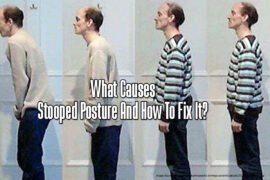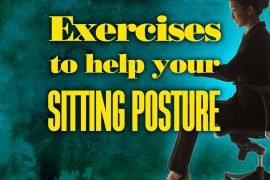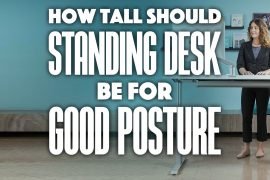Understanding Posture
Table of Contents
Before we dive into how to fix bad posture, it’s important to understand what posture is and why it’s important. Posture refers to the situation in which you hold your body while lying, standing, or sitting down. Good posture is when your body is in alignment, with your head, shoulders, and hips in a straight line. This alignment helps to distribute your body weight evenly, reducing the strain on your joints and muscles.
Poor posture, on the other hand, is when your body is out of alignment. This can happen when you slouch or hunch your shoulders forward. Over time, poor posture can lead to muscle imbalances, which can cause pain and discomfort.
Causes of Bad Posture
There are different factors that can contribute to bad posture, including:
Sedentary Lifestyle
One of the primary causes of bad posture is a sedentary lifestyle. People who spend a very long time sitting in front of a TV, computer, driving, or reading often develop a slouched posture, with rounded shoulders and a forward head position. Sitting for prolonged periods weakens the muscles that support the spine, leading to strain on the neck, shoulders, and back.
Poor Ergonomics
Another significant cause of bad posture is poor ergonomics or the way people interact with their work environment. This can include using a poorly designed desk, chair, or computer that does not support the body’s natural alignment. For example, sitting in a chair that is too low or high can cause strain on the lower back, while using a computer monitor that is too high or low can cause neck and shoulder pain.
Muscular Imbalances
Muscular imbalances occur when certain muscles in the body are stronger or tighter than others. This can cause the body to compensate by adopting a posture that puts undue strain on other muscles and joints. For example, tight hip flexors can cause the lower back to arch excessively, leading to lower back pain.
Poor Footwear
The shoes that people wear can also contribute to bad posture. High heels, for example, force the body’s weight forward onto the toes, causing the lower back to arch and the shoulders to round forward. On the other hand, flat shoes offer little support for the arches of the feet, leading to overpronation and inward rolling of the ankles.
Obesity
Obesity is another cause of bad posture, as excess weight puts strain on the joints and muscles of the body. People who are overweight or obese can find it more difficult to maintain good posture, as their weight may pull them forward or cause them to slump.
Poor Sleeping Habits
Poor sleeping habits, like sleeping on an old sagging mattress or pillow, can also contribute to bad posture. Sleeping on a mattress that is very hard or soft can cause the spine to curve unnaturally, leading to neck and back pain.
Stress
Stress is a common cause of bad posture, as it can cause people to tense their muscles and hold their bodies in a rigid position. This can lead to tightness and pain in the neck, back, shoulders, and as well as headaches and other physical symptoms.
Lack of Exercise
Lack of exercise can also contribute to bad posture, as weak muscles are more prone to strain and injury. Regular exercise may help strengthen the muscles that support the spine and improve posture.
What are the Effects of having a Bad Posture?
You aren’t only doing something to make you feel better when you modify your posture; instead, you’re taking a significant step toward preventing various problems that can impact you in the future. In other words, having poor posture may have far more negative health consequences than you realize. Here are some of the most recognized adverse effects of bad posture:
Musculoskeletal Issues
Poor posture can lead to various musculoskeletal problems, including neck and back pain, headaches, and shoulder pain. When the spine is misaligned or not in its natural curvature, it places pressure on the muscles, tendons, and ligaments that support it. This can cause muscle fatigue, tension, and pain. Additionally, poor posture can lead to a loss of flexibility and range of motion in the joints, making it more challenging to move comfortably and perform daily activities.
Digestive Issues
When the body is hunched forward or slouched, it can compress the internal organs, leading to digestive issues like acid reflux, constipation, and bloating. This is because the organs need sufficient space to function correctly. If they are compressed or pushed out of their natural positions, they can become constricted, leading to digestive problems.
Respiratory Problems
Bad posture can also hurt the respiratory system. When the body is slouched or hunched forward, it can compress the lungs, making breathing harder. This can lead to shortness of breath, shallow breathing, and even respiratory problems like asthma.
Cardiovascular Issues
Poor posture can also contribute to cardiovascular issues such as high blood pressure and an increased risk of heart disease. When the body is slouched or hunched forward, it can compress the chest cavity, limiting the amount of space available for the heart and lungs to function properly. Over time, this can put a strain on the cardiovascular system, leading to chronic health issues.
Mood and Energy
Bad posture can also have an impact on mood and energy levels. When the body is hunched over or slouched, it can cause fatigue, lethargy, and a lack of motivation. This is because poor posture can interfere with oxygen and blood flow to the brain, leading to mental fogginess and decreased alertness.
Self-Confidence
Posture can also affect how others perceive us and how we feel about ourselves. People with good posture tend to appear more confident, assertive, and attractive. On the other hand, people with poor posture may be seen as less confident, less attractive, and less assertive. This can have a negative impact on self-esteem and confidence levels.
Sleep Problems
Poor posture can also contribute to sleep problems such as snoring, sleep apnea, and insomnia. When the body is hunched over or slouched, it can put pressure on the airways, leading to breathing difficulties during sleep. Additionally, poor posture can cause discomfort and pain, which makes it harder to fall and stay asleep.
Increased Risk of Injury
Finally, bad posture can increase the risk of injury. When the body is misaligned or not in its natural curvature, it can make it more challenging to move safely and correctly. This can lead to increased strain on the joints, muscles, and bones, making an injury more likely to occur.
Various Ways To Improve Your Posture
The following is one of the most important ways to improve your posture if you don’t have a significant issue like an injury or prior surgery that causes your misalignment.
Stand Tall
Standing tall is one of the easiest ways to improve your posture. Stand with your feet hip-width apart and relax your shoulders. Activate your core muscles by pulling your belly button in towards your spine. Keep your chin level and eyes focused straight ahead. Make sure to distribute your weight on both feet and avoid locking your knees.
Sit Up Straight
If you spend plenty of time sitting, it’s important to pay attention to your posture while seated. Sit with your back straight, and relax your shoulders. Keep your feet flat on a floor and your knees bent at a 90-degree angle. Use a chair that supports your back, or consider using a lumbar roll or cushion to support your lower back.
Stretch Your Chest
Many people develop poor posture due to tightness in their chest muscles. To counteract this:
- Try stretching your chest regularly.
- Stand in a doorway with outstretched arms, and bend your elbow at a 90-degree angle.
- Place your forearms on the door frame and lean forward until you feel a chest stretch.
- Hold for 30 seconds and repeat several times.
Strengthen Your Back
Weak back muscles can also contribute to poor posture. Try exercises like rows, pull-ups, and back extensions to strengthen your back. These exercises will help to improve your posture by pulling your back and shoulders and opening up your chest.
Use A Standing Desk
Sitting for long periods of time can be hard on your back and neck. If you have a desk job, consider using a standing desk. This will allow you to alternate between sitting and standing the whole day, which can help to improve your posture and reduce the danger of back pain.
Practice Yoga
Yoga is a perfect way to improve your posture and increase your flexibility. Many yoga poses focus on strengthening the back, stretching the chest and shoulders, and improving overall body awareness. Consider taking a yoga class or practicing at home using a yoga video.
Wear Supportive Shoes
Wearing shoes with good support can also help to improve your posture. Avoid high heels or shoes with no arch support, as these can put undue stress on your feet, knees, and back. Look for shoes with a supportive arch and a cushioned sole.
Be Mindful of Your Posture While Driving
Many people spend a lot of time driving, which can also contribute to poor posture. To improve your posture while driving, adjust your seat so that your hips are level with your knees and your back is supported. Keep your shoulders relaxed and avoid leaning forward or slouching.
Take Frequent Breaks
If you spend most time sitting or standing in one position, it’s essential to take frequent breaks to stretch and move around. This will help to improve circulation and reduce the risk of muscle fatigue and stiffness.
Get Regular Exercise
Regular exercise is important for maintaining good posture and overall health. Aim for atleast 30 minutes of moderate exercise most days of the week. This could include activities like walking, cycling, swimming, or strength training.
Exercises and Stretches To Fix Bad Posture
“Bad posture,” which is a collection of various spine problems, affects the spine in multiple regions. They result in additional posture issues appearing and getting worse in a chain reaction. Poor posture takes on similar shapes in most individuals and may be recognized by their postural features. The goal is to discover the one that matches your criteria and works to repair the muscular imbalances that come with it. Here, we’ve outlined the most common posture disorders and given you essential clues and exercises to address them.
Chin Tucks
Chin tucks are a great exercise for improving posture, especially for those who spend very long hours sitting in front of a desk or computer. Chin Tucks exercise strengthens the muscles that support the head and neck, which may help reduce neck pain and headaches.
To perform a chin tuck, sit up straight in a chair with your shoulders relaxed. Then suck your chin down towards your chest and keep your eyes forward. Hold this posture for 5-10 seconds, then relax. Repeat this exercise 10-15 times.
Shoulder Blade Squeeze
The shoulder blade squeeze is another excellent exercise for improving posture. This exercise strengthens the muscles in your upper back, which can help prevent shoulder and neck pain.
To perform a shoulder blade squeeze:
- Sit up straight in a chair with relaxed shoulders.
- Squeeze your shoulder blades together like you are trying to hold a pencil between them.
- Hold this posture for 5-10 seconds, then relax.
- Repeat this exercise 10-15 times.
Wall Angels
Wall angels are a perfect exercise for improving posture and reducing upper back pain. This exercise strengthens your upper back, shoulders, and chest muscles.
To perform the wall angels exercise:
- Stand with your back against the wall & let your feet be 6 inches away from the wall.
- Raise your arms to the height of the shoulder and bend your elbows to 90 degrees so your hands point toward the ceiling.
- Please slide your arms up the wall gradually while making sure to maintain contact with the wall using your elbows and wrists.
- When you can no longer keep your elbows and wrists in contact with the wall, slide your arms back down to starting position.
- Repeat this exercise 10-15 times.
Chest Stretch
The chest stretch is a great exercise for improving posture and reducing neck and shoulder pain. This exercise stretches the muscles in your chest and shoulders, which can help counteract the effects of hunching over a desk or computer.
Stand with your feet shoulder-width apart & the arms at your sides to perform a chest stretch. Reach behind your back with both hands and clasp them together. Slowly raise your arms up and away from your body until you feel your chest and shoulders stretch. Hold this stretching for 15-30 seconds, then release it. Repeat this exercise 3-5 times.
Cat-Cow Stretch
The cat-cow stretch is a perfect exercise for improving posture and reducing back pain. This exercise stretches the muscles in your back and hips, which can help improve spinal flexibility and reduce pain.
To perform a cat-cow stretch, get on your hands or knees with your wrists directly under your shoulders & your knees straightly under your hips. Arch your back, and lift your head & tailbone towards the ceiling while inhaling. This is the cow position. Round your spine by exhaling, tucking your chin to your chest, & bringing your tailbone towards your knees. This is the cat position. Repeat this movement 10-15 times.
Hip Flexor Stretch
Hip flexor stretch is an effective stretching exercise that targets the muscles at the front of the hip, including the iliopsoas and rectus femoris. This exercise can be performed by kneeling on the floor with one knee bent at a 90-degree angle and the second leg stretched out behind you. As you lean forward, you should feel a stretch in front of your hip and thigh. This stretch can help improve flexibility, reduce muscle tightness, and alleviate lower back pain. It is especially beneficial for athletes, runners, and individuals who spend long periods sitting, as tight hip flexors can lead to posture problems and lower back pain. Regularly performing the hip flexor stretch can help improve mobility and overall physical health.
What Does Bad Posture Look Like
Several daily activities can contribute to posture issues or exacerbate existing problems. In this part, we’ll look at each position and how you may improve your posture while performing it.
Standing Posture
The standing posture is important for maintaining balance and reducing pressure on your joints. Standing with poor posture can cause problems such as back pain and knee pain. Standing with your shoulders slouched forward, and your head down can lead to a hunched back, rounded shoulders, and neck pain. To maintain good posture while standing, you should stand tall with your shoulders back, your chest out, and your head held high.
Walking Posture
Walking with poor posture can cause various problems, such as knee, hip, and back pain. Walking with your shoulders hunched forward and your head down can lead to neck pain and back pain. Walking with your feet pointing outward can cause knee pain. To maintain good posture while walking, you should stand tall with your shoulders back, your chest out, and your head held high.
Lifting Posture
Lifting heavy objects with poor posture can cause back pain and muscle strains. When lifting heavy objects, you should use your legs to lift, not your back. Also, you should keep your back straight and your shoulders back. It is important to avoid twisting your back while lifting heavy objects.
Driving Posture
Driving posture is important for maintaining good posture and reducing the risk of developing back pain. Driving with poor posture can cause problems such as neck pain and back pain. To maintain good posture while driving, you should adjust your seat so that your feet can reach the pedals easily. Also, you should keep your back straight, and your shoulders relaxed.
Sleeping Posture
Sleeping posture is important for maintaining a healthy spine and reducing the risk of developing back pain. Sleeping on your stomach can cause problems such as neck pain and back pain. Sleeping on your back may lead to snoring and sleep apnea. Sleeping on your side is the best sleeping posture for maintaining good posture. You should also use a pillow that supports your neck and spine.
Sitting Posture
Bad sitting posture can cause various problems, such as a stiff neck, back pain, and reduced blood flow. Sitting with a hunched back and shoulders can lead to discomfort in the lower back and neck. Also, sitting with a curved back and slouched shoulders can reduce your lung capacity and make it difficult to breathe. To maintain good posture while sitting, you should place your feet flat on the ground & your knees at a 90-degree angle, your back straight, and your shoulders relaxed.
Things To Avoid While Suffering From Bad Posture
Slouching
One of the most general causes of bad posture is slouching. When you slouch, you put additional pressure on your back muscles, which can lead to pain and discomfort. To avoid slouching, make sure you sit up straight and keep your shoulders back. You can also use a lumbar roll or pillow to support your lower back.
Using a laptop on your lap
Using a laptop on your lap can also contribute to bad posture. Whenever you use a laptop on your lap, you are forced to look down at the screen, which can cause neck and shoulder pain. Instead, try to use a desk or table to work on your laptop, and make sure the screen is at eye level.
Carrying a heavy bag
Carrying a heavy bag can also lead to bad posture. When you carry a heavy bag, you tend to lean to one side to balance the weight, which can cause muscle strain and discomfort. To avoid this, try to carry lighter bags or backpacks, and make sure you distribute the weight evenly.
Wearing high heels
Wearing high heels can also contribute to bad posture. When you wear high heels, you shift your weight forward, which can cause strain on your lower back and legs. To avoid this, try to wear shoes with a lower heel or switch to flats when possible.
Sitting for long periods
Sitting for long periods can also contribute to bad posture. When you sit for long periods, you tend to slouch and put extra pressure on your back muscles. To avoid this, try to take breaks and walk around every hour or so. You can also do some stretches to help loosen up your muscles.
Using your phone or tablet for long periods
Using your phone or tablet for long periods can also contribute to bad posture. When you use your phone or tablet, you tend to hunch over and put extra pressure on your neck and shoulders. To avoid this, try to hold your phone or tablet at eye level and take breaks every 20-30 minutes.
Sleeping on your stomach
Sleeping on your stomach may also contribute to bad posture. Whenever you sleep on your stomach, you have to twist your neck to breathe, which can cause strain on your neck and shoulders. To avoid this, try to sleep on your back or side and use a pillow to support your neck.
Slouching while driving
Slouching while driving can also contribute to bad posture. When you slouch while driving, you put extra pressure on your back muscles, which can lead to pain and discomfort. To avoid this, make sure your car seat is adjusted properly, and use a lumbar roll or pillow to support your lower back.
Lifting heavy objects improperly
Lifting heavy objects improperly can also contribute to bad posture. When you lift heavy objects, you tend to bend over and put extra pressure on your back muscles. To avoid this, make sure you use proper lifting techniques, like lifting with your legs instead of your back.
Ignoring pain or discomfort
Ignoring pain or discomfort can lead to further damage and make it harder to correct your posture. If you are experiencing pain or discomfort, make sure you address the issue by seeking medical attention or adjusting your posture and daily habits. It is essential to listen to your body and take action to prevent further damage. Ignoring pain or discomfort may lead to chronic pain, which can severely impact your quality of life. So, take care of your body and address any issues promptly.
FAQs
Q1. Can you correct years of bad posture?
It is possible to improve your posture, even if it has been a problem for a long time. It is common to believe that rounded shoulders and a hunched stance are permanent once we reach a certain age. You might also think that it is too late to improve your posture. You can improve your posture and stand taller.
Q2. What causes bad posture?
Poor posture is often caused by bad habits like slouching and inactivity that result in muscle fatigue and tension as we get older. Poor posture can lead to various complications, such as back pain, spinal malfunction, joint degeneration, rounded shoulders, and a protruding belly.
Q3. Does yoga improve posture?
Yoga has many benefits beyond just increasing flexibility. It can improve posture, which enhances body shape and alleviate back and neck pain.
Q4. Does posture get worse with age?
The vertebral column, which is also known backbone, comprises vertebrae bones, intervertebral discs, and muscles. Aspects are greatly affected by age, and as time passes, there is a tendency for the back to curve forward, creating a more hunched posture.
Q5. Does Surya Namaskar fix posture?
Performing Surya Namaskar regularly can provide several health benefits. Improving the strength and flexibility of the spine can enhance the general posture of the body. Improve blood circulation throughout the entire paraspinal and spinal area.
Q6. Can bad posture change your face?
Poor body alignment can weaken the muscles in the chin and neck. Slouching has a significant impact on the muscles in your face, causing your skin to sag more. When we have rounded shoulders, it can affect our jawline, cause tightness in our chests, and even lower our self-confidence.
Q7. What percent of people have bad posture?
According to (NIH) National Institutes of Health, more than 80% of Americans will experience back problems at some point in their life. Poor posture, which used to be seen as only a cosmetic issue, is now recognized as a significant contributor to these problems by experts.
Q8. Does bad posture make you weaker?
Bad posture can exacerbate and potentially cause muscle damage if you already have a strained back. Maintaining proper posture ensures that weight is evenly distributed on the body’s load-bearing areas. Sitting the wrong way can apply pressure on parts of your body that shouldn’t bear weight.
Q9. Is bad posture noticeable?
Poor posture can cause various physical signs, with the hunchback and forward neck positions being the two most frequently observed ones. Hunchback is a condition characterized by excessive rounding of the upper back with a forward slope. Forward head carriage refers to a condition where the head is tilted forward, causing extreme pressure on the neck joints.
Q10. Does bad posture change face shape?
The chin and neck muscles can weaken if one frequently slouches or looks down. The way our posture influences our facial muscles to work. If you have rounded shoulders, it can affect your jawline, make your chest feel tight, and have an impact on your self-confidence. Improving your posture may help in reducing the double chin.
Conclusion
Fortunately, restoring poor posture is feasible. However, it takes a firm commitment to do corrective exercises and maintain certain habits like getting more active. Most people’s postural problems can be addressed by completely shifting their lifestyle – reduced technology and more movement. You may also make your regular sitting environments more ergonomic to decrease postural strain accumulation over the course of the day. Furthermore, you may adjust your sleeping posture and avoid adding to your posture concerns. The second step is knowing, so once you’ve got the information on how to improve your posture, the rest is up to you. If you have an injury or a health problem, consult with your doctor before doing any of these activities.








